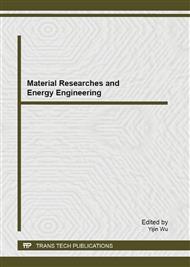p.325
p.331
p.337
p.343
p.349
p.355
p.359
p.365
p.371
Preparation of Graphene/Pd Nanoparticle Composites and their Hydrogen Storage
Abstract:
Pd (en)2Cl2 can be intercalated into graphite oxide layers with high efficiency. The Pd (en)22+ intercalated graphite oxide was firstly synthesized by mixture reaction of Pd (en)2Cl2 and graphite oxide, then it was reduced in solution with NaBH4 and thereafter the graphene/Pd nanosized particle composites were obtained. The graphene composites were characterized by XRD, FE-SEM, TEM, ICP and N2 adsorption tests and their H2 storage was also measured. The results show that the composites contain a large amount of Pd and have a regular mesoporous structure, and Pd particles with a diameter of 2-6 nm are evenly dispersed between graphene sheets and pillar the graphene sheets. The BET surface area of the composites is 230 m2/g and their H2 storage reaches 3.4 wt.% at 77K and 0.11 MPa.
Info:
Periodical:
Pages:
349-354
Citation:
Online since:
September 2013
Authors:
Keywords:
Price:
Сopyright:
© 2013 Trans Tech Publications Ltd. All Rights Reserved
Share:
Citation:



